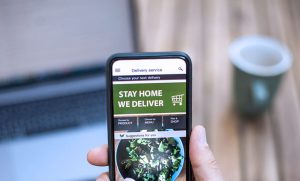eCommerce in the Era of COVID-19
 Our way of life changed in March. The impact of the Coronavirus pandemic will be felt long after the states lift lockdown provisions and we collectively, and slowly, return to normalcy. During this challenging period of self-isolation, many governors have ordered brick & mortar locations to close for an extended period in the name of public safety. Businesses considered essential, like many grocery stores, are understaffed due to employees on sick leave and those who feel apprehensive about working in a human-to-human contact environment.
Our way of life changed in March. The impact of the Coronavirus pandemic will be felt long after the states lift lockdown provisions and we collectively, and slowly, return to normalcy. During this challenging period of self-isolation, many governors have ordered brick & mortar locations to close for an extended period in the name of public safety. Businesses considered essential, like many grocery stores, are understaffed due to employees on sick leave and those who feel apprehensive about working in a human-to-human contact environment.
With this shift in the consumer landscape comes a massive rise in remote work across industries, and a variety of workers spending more time at home than ever before. This leads to more consumers purchasing online than ever before, which means retailers need to have a media strategy in place to get their products in front of these potential customers at the right time in a manner that demonstrates empathy, and ideally demonstrates thought leadership. Brands that have not adequately prepared for the shift to eCommerce are at risk of losing business to competitors that have successfully adapted to the changing marketplace.
The impact of increased eCommerce behavior can be felt across all major marketplaces and platforms. According to e-Marketer, general eCommerce activity across the health/wellness and grocery/CPG industries is seeing a short-term growth period. Amazon is experiencing a surge in searches for essential items like soap and hand sanitizer, while outside of Amazon, other trusted retailers are also seeing a surge in eCommerce activity. According to Ad Age, the first three weeks of March saw site traffic increases between 19% and 40% for Target, Walmart and Costco. ComScore data showed Amazon visits up 28% from March 1 through March 16. These volume trends will likely continue well into the early summer, depending on how quickly we are able to collectively “flatten the curve” of the pandemic.
Retailers that have been able to quickly pivot to capture an increase in eCommerce activity are reaping the rewards while slow-footed competitors fall behind; they’re able to directly communicate with their customers and drive sales via their own websites, owned media, and third-party marketplaces. Specific to the category, grocery stores and CPG brands can advertise their products on mobile apps like Instacart to emphasize home delivery, fast food brands like Burger King, Wendy’s and Chipotle are now offering free delivery, and a wide variety of brick & mortar retailers are selling discounted gift cards for current or future use to keep cash flowing and maintain relationships with customers.
Some of the biggest names in the eCommerce space are taking this moment to seize market share and create new jobs despite the current climate. Retail giant Walmart has even begun scaling up operations across the supply chain, announcing the hiring of “150,000 associates, and these include full-time, part-time and temporary positions in distribution centers (DCs) and fulfillment centers (FCs).” Although a volume surge can be viewed as a short term increase brought on by necessity, there are many (traditionally) in-store shoppers that are now acclimating to online shopping for the first time, and a significant percentage may continue to do so after conditions return to pre-pandemic norms.
Brick & mortar retailers that have previously used their website as an information and education resource, rather than a virtual shopping cart, need to quickly pivot to an eCommerce business model with a fully functional website. There are many ways brands can improve their eCommerce strategy, but it depends on their unique business model and customer set. It’s important to remember that states, counties and cities have responded to the pandemic differently, so brands should be aware of the restrictions on travel, operating hours, and general obstacles that the pandemic has created for individuals and families – all while keeping in mind that this is an opportunity to provide real value for customers when they need it most. Our eCommerce team at Harmelin is here to provide guidance and strategy for your brand while we navigate this new era in the business world together.


